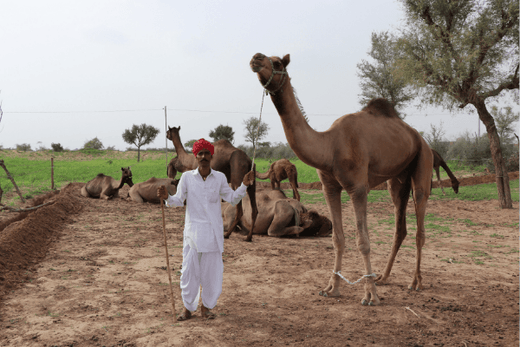Old MacDonald had a farm.
Many of you might be familiar with Old MacDonald and his farm that buzzed with different animals. He had cows, chicks, and even pigs – who all made a lot of noise. (Oink!) I bet a lot of you might never have imagined Old MacDonald with (wait for it), a Camel!
Bleat.
As surprising as it sounds, camels are just as deserving when it comes to being a cherished farm animal, and if recent trends are to be believed, then the newer generations might be a lot more familiar with the idea of a camel.
A Tradition for Many
Camels are reared as livestock in many countries around the world, where Saudi Arabia and Oman are known to be topping the charts globally. Eastern African countries like Kenya, Mali, and Sudan also feature among the countries with the largest population of camel livestock. In these countries, camels are traditionally raised not only for commodities such as milk, meat, and wool but also for transport.
The global camel population currently stands at over thirty-five million. However, only a very small percentage of these camels are raised as a part of commercial farming. In countries like India, commercial farming of camels has dwindled since a ban was put on camel meat and it was evident that dairies were not commercially viable back in the day.
In countries in Eastern Africa, such as Kenya, on the other hand, camel farmers are said to be thriving in the recent past. Individual farmers in Kenya reportedly own over twelve million camels.
Why are Camels Special?
Apart from the traditional uses of camel milk in some cultures, a major reason for the popularity of camel farming in these countries is the ability of camels to withstand hot, dry, and arid climates. Unlike cows or goats, camels can survive up to three dry seasons and not succumb in the absence of rain.
This has made camel milk an important dietary component in some developing nations. While several claims suggest that camel milk may have unique nutritional properties, including possible benefits for immunity and allergies, these claims are not yet fully supported by conclusive scientific evidence. Due to its limited consumption in developed nations historically, camel milk has not received as much widespread research focus compared to other dairy variants.
The Step towards Global Recognition
Camel milk has slowly started gaining popularity across the world with more people becoming curious about it. Currently, the camel milk industry is estimated to be worth several billion dollars annually, according to various reports.
In the United States, camel milk is now available in select major grocery stores.
In the past, most of this was imported in frozen form because of the lack of camel farms in Western nations. However, in the last five years, there has been gradual growth as more players join the camel farming business. A few companies have successfully introduced commercial camel farming in the United States and also recently made inroads into the United Kingdom.
Such camel dairy farms also include businesses that have started introducing variants of camel milk into products such as ice cream. If news reports are accurate, a majority of the camels reared in farms in the United States live in farms owned by the Amish and Mennonites. Quite a few small-scale farms have also opened recently, dealing in camel milk as well as soaps and lotions.
Ultimately, it might not be long before the camel milk industry undergoes further development. This could encourage more research and studies to better understand the potential benefits and properties of camel milk. Looks like milk lovers are in for a new dairy variant making its way into global markets.


3 comments
i want to work with this company
Deseo saber cómo hago para importar camellos para criar en el meta Colombia clima caliente
I read your article when I was researching the possibility of raising camels in cold regions. What saddened me and made me write to you is that you did not mention in your article that the largest number of camels in the world lives in Somalia. I wish I knew why this information was not mentioned, so let it be known. How important are camels and how proud are Somalis of breeding camels?